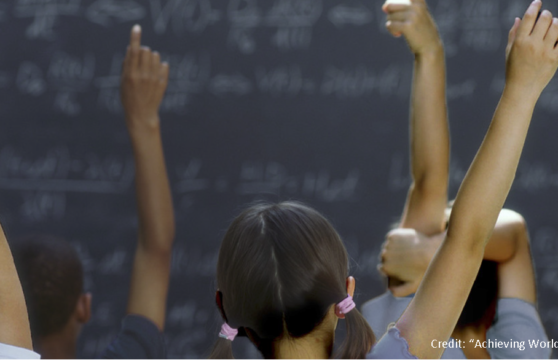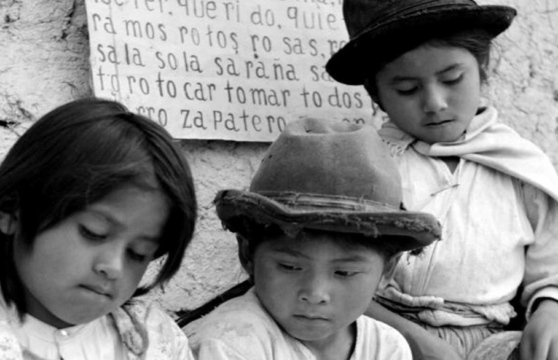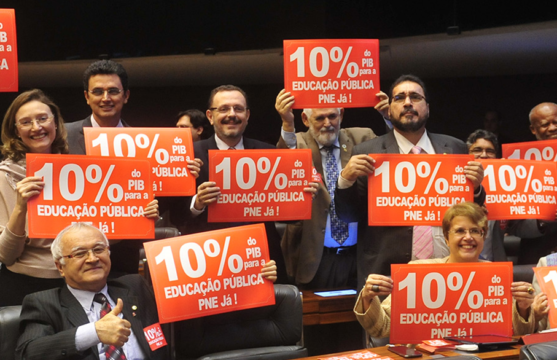
Achieving World Class Education in Brazil
An analysis of Brazilian education and the four recommendations offered to better compete with OECD systems by 2021.
This post is also available in: Spanish
It is an honor to announce the appointment of Alejandro Ganimian as a Non-Resident Fellow of the Education Program at the Inter-American Dialogue. The following is an interview between our Director Ariel Fiszbein (AF) and Ganimian (AG).
AF: Ale Ganimian, it’s an honor to have you as a Fellow at the Inter-American Dialogue. What prompted you to accept our invitation to collaborate with the education program at the Dialogue?
AG: My relationship with the Dialogue goes back 10 years. In 2005, I worked as an intern with the education program (PREAL) for a year, and in 2007 I became program associate for two years.
I think the Dialogue was a pioneer in doing something that no one was doing ten years ago: “translating” the findings from rigorous research into the language of decision makers and the general public.
In particular, through the Educational Progress Reports (Informes de Progreso Educativo), which I worked on alongside Tamara Ortega Goodspeed, the Dialogue began to make the debate on education policy a debate for everyone—not only for economists at multilateral banks, or professors at schools of education. These reports present clear and trustworthy information we can all understand and use to evaluate how the region’s education systems are performing. This has been fundamental in creating a greater demand for higher quality education.
Fortunately, since the Dialogue began doing these reports, new actors have started to do a similar kind of work. I believe this makes it necessary for the Dialogue’s role to evolve so that it may find its new comparative advantage, and I am thrilled to be a part of this evolution.
AF: In your opinion, what are the main obstacles that Latin American countries face in improving learning levels in schools? What should committed governments prioritize to improve education quality?
AG: I believe the region encompasses groups of countries with very different educational challenges. The most important thing in each country is to identify the limiting factors, design a response based on a theory of action informed by the best available evidence, and evaluate this response to determine if the objective was met.
In some countries (e.g., Bolivia, Paraguay, and most of Central America), the main challenge is ensuring that more children and youth enroll in and finish school. The most rigorous impact evaluations suggest several ways of doing this, including informing the poorest about the economic returns to education, subsidizing the cost of educational complements (such as uniforms or eyeglasses), compensating low-income parents for the opportunity-cost of sending their children to school, or expanding schooling options.
In other countries (e.g., Argentina, Brazil, Ecuador, Mexico, and Peru), a big challenge is ensuring that children and youth acquire basic skills—particularly in language and math. There are several interventions that have been evaluated that could be helpful in tackling this issue. For example, creating teaching guides for the least-qualified teachers, providing after-school remedial help for students who are falling behind in class, adopting computer tutoring programs with adaptable degrees of difficulty, or dedicating part of the school calendar to learning groups divided by performance level (instead of by grade).
In a very limited number of education systems (e.g., Chile, Costa Rica, Uruguay, and some sub-national systems), the main challenge is to improve teaching skills to go beyond basic competencies. We have less solid evidence on how to achieve this. Teacher incentives could play an important role in motivating teachers who know how to improve, and could benefit from higher salaries. However, these incentives are less promising for teachers who need help in order to improve. Here, the key seems to be in experimenting with different systems of recruitment, selection, clinical practice, induction and teacher feedback, and to evaluate these experiments rigorously.
AF: You recently completed your doctoral thesis at Harvard University. Can you briefly tell us about it?
My thesis asks a very simple question: if we see an aspiring teacher practice teaching during his training, does this tell us anything about the way he will teach once he enters the school system? I tried to answer this question, alongside Mariana Alfonso, an economist at the Inter-American Development Bank, and Andrew Ho, a psychometrician at Harvard’s School of Education.
The question is important for two reasons. First, the indicators that we currently use to hire teachers (certification, experience, and postgraduate degrees), tell us very little about how teachers will perform once they enter the classroom. Second, once a teacher enters the system, his/her performance after one year (measured through student exams, student and school principal surveys, and in-class observations) tell us a lot about a teacher’s performance on the following year. The key question is, then: can teaching practice tell us something before a teacher enters the system?
To explore this question, we took advantage of the fact that there are over 35 alternative pathways into teaching, grouped under the organization Teach for All, that require two weeks of clinical practice before teachers enter the classroom. In those two weeks of practice in one of these programs, Enseñá por Argentina (Teach for Argentina), we assessed teacher effectiveness through different measurements, including student surveys and in-class observations. Then, throughout the school year, we assessed them again.
We found evidence suggesting that these measurements during clinical practice can predict the same measurements during the school year. In fact, even very short in-class observations during the clinical practice process predict teacher performance in these measures during the school year.
AF: In these years, you were at one of the most important centers for educational research in the United States, and this gave you a privileged perspective. What would you say is the most noteworthy advancement in education policy research that you have perceived?
AG: What I celebrate the most has been the application of research methods that allow us to know the causal effects of education policies. Until very recently, the majority of what we “knew” about education was based on correlations. For instance, in any given year, Ariel participates in Program X, and the next year, Ariel performs better in Math. We used to assume that Ariel had performed well because of Program X. The problem with correlations is that they can be driven by other factors. Perhaps Ariel is very motivated, and motivation (and not Program X) is what made him perform better in Math.
Some years ago, this began to change. Two economists at the Massachusetts Institute of Technology (MIT) proposed a very simple way of rigorously evaluating the effect of education policies. Esther Duflo and Abhijit Banerjee said: first, let’s recruit all of the “Ariels” that want program X; then, let’s randomly assign half of them to program X, and the other half to no program. In this way, the “Ariels” who participate in the program and those who do not will be comparable from the beginning. Thus, when we observe their Math performance a year later, we will be able to make sure that the only thing in which these groups differ is that one of them participated in the program.
In 2003, Duflo and Banerjee founded a research center at MIT called the Abdul Latif Jameel Poverty Action Lab (J-PAL), which began to evaluate education programs (and other sectors such as agriculture, the environment, finance, government and labor) using this method.
It was not a novel idea—it is the way new medications are evaluated before they are approved for sale. Neither was it the first time it was applied to education—some economists had already done this type of studies before J-PAL was founded, such as Harvard’s Michael Kremer. But this development has allowed us to form a body of knowledge in education that we did not have until recently. And in various cases, these evaluations have challenged “conventional wisdom.” For instance, several policies that are popular in Latin America—such as endowing schools with computers—have not improved student performance, despite having been repeatedly evaluated in different contexts.
In my opinion, we are not yet taking full advantage of the body of knowledge that is being developed. This is why PREAL’s role in translating these findings for the public is so fundamental. I hope to be able to contribute to this work.
AF: How do you perceive education research in Latin America and its impact on public policies?
AG: I think it is a field that encompasses very diverse people and organizations.
The World Bank, the Inter-American Development Bank, and especially J-PAL, are playing an important role in evaluating the effects of education policies.
Also, MIDE UC in Chile, INEP in Brazil, INEE in Mexico, and other education evaluation agencies, are playing a fundamental role in assessing the performance of students and teachers in the region.
Mexicanos Primero, Chile 2020, and Todos Pela Educação also play a key role in conducting less academic research that focuses more on generating information that is relevant to education policy.
In spite of these efforts, I believe that in the field of education, we could benefit from training those who complete Masters or PhDs in Education in quantitative methods. I believe that until now, we have been more successful in training these students in qualitative methods, and it would be beneficial that they be trained in both methodologies. This does not mean giving a higher priority to some discipline in particular (such as Economics). In the United States, qualitative methods abound in Political Science, Psychology, and Sociology. I believe that achieving a more comprehensive training for our students of Education would greatly help us in generating better evidence.
AF: You recently arrived to Delhi, where you will work with J-PAL. What are your first impressions about the challenges and opportunities in the field of education?
AG: Exactly. For two years, I will be working with Karthik Muralidharan, co-director of the education program at J-PAL, and Esther Duflo, scientific director of J-PAL South Asia, to set an education and human development agenda and develop new projects that can contribute to this research program. I am very fortunate; this is a great opportunity.
J-PAL South Asia has been a leader in generating rigorous evidence on what works in education, and I am thrilled to be a part of that team. I think it will be a great learning experience for me in terms of learning how to carry out better education policy evaluations, and how to ensure that the lessons from these evaluations are incorporated in practice.
AF: In addition to being a researcher, you are also an activist for higher quality education for the most vulnerable children and youth. You are one of the founders of Enseñá por Argentina and a regular collaborator to several NGOs in the field of education in Argentina and Latin America at large. Are these two parallel activities, or do they complement each other?
AG: I don’t know if I would call myself an activist, but I do like to work simultaneously on policy, practice, and research within education. In fact, I find it hard to imagine my work any differently.
When I recommend public policies, I need to understand how the body of knowledge on what works in education is developed, and that is where my training as a researcher is very useful. But I also need to know how the policies I will recommend work in practice, and in that respect, I learn from my work with Enseñá por Argentina and Educar y Crecer
Similarly, when I advise non-governmental education organizations on how to design their programs, I try to ensure they complement existing education policies, and that is where my work in public policy is helpful. But I also need to know what other organizations are doing and how well other programs are working, so I need to stay informed about the most recent impact evaluations.
Lastly, when I work as a researcher, I like to produce studies that are relevant to decision makers, and that’s where my experience in public policy helps me a lot. But I also need to know about the most promising innovations that have not yet been implemented at a large scale, and this I learn from the non-profit sector.
An analysis of Brazilian education and the four recommendations offered to better compete with OECD systems by 2021.
In order to ensure that education quality receives the attention it deserves, the discussion of learning goals must be taken to the streets.
Brazilian Congress passed a new National Education Plan. What are its goals?

